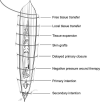The Historical Role of the Plastic Surgeon in Spine Reconstruction
- PMID: 33994871
- PMCID: PMC8110360
- DOI: 10.1055/s-0041-1722852
The Historical Role of the Plastic Surgeon in Spine Reconstruction
Abstract
Wound complications occur in up to 19% of patients undergoing complex spine surgery. The role of the plastic surgeon in complex and redo spine surgery is important and evolving. Classically, plastic surgeons have been involved in the management of patients who develop wound complications following surgery. This involves reconstruction of posterior trunk defects with locoregional fasciocutaneous, muscle, and free tissue transfers. There has also been an increasing role for plastic surgeons to become involved in prophylactic closures of complex and/or redo spine surgeries for high-risk populations. Identification of patients with comorbidities and likelihood for multiple reoperations who are prophylactically treated with complex closure with or without local muscle flaps could significantly decrease the postoperative wound complications.
Keywords: complex closure; complications; plastic surgery; spine surgery.
Thieme. All rights reserved.
Conflict of interest statement
Conflicts of Interest Dr. Hansen is part of the Speakers Bureau for Smith and Nephew, but this commitment has no conflict with this report.
Figures









Similar articles
-
Comparison of Plastic Surgeon and Spine Surgeon Closure in Revision Short Segment Thoracolumbar Spinal Fusions.Spine (Phila Pa 1976). 2021 Sep 15;46(18):1279-1286. doi: 10.1097/BRS.0000000000003984. Spine (Phila Pa 1976). 2021. PMID: 34435992
-
Plastic Surgery Closure of Complex Spinal Wounds.J Am Acad Orthop Surg. 2023 Sep 1;31(17):e610-e618. doi: 10.5435/JAAOS-D-23-00129. Epub 2023 May 5. J Am Acad Orthop Surg. 2023. PMID: 37155731 Review.
-
Locoregional Flap Closure for High-risk Multilevel Spine Surgery.Plast Reconstr Surg Glob Open. 2020 Apr 21;8(4):e2751. doi: 10.1097/GOX.0000000000002751. eCollection 2020 Apr. Plast Reconstr Surg Glob Open. 2020. PMID: 32440420 Free PMC article.
-
Locoregional Flaps in Oncoreconstruction at a Tertiary Cancer Centre in North East India: a Review Through a Plastic Surgeon's Eye.Indian J Surg Oncol. 2020 Sep;11(3):486-491. doi: 10.1007/s13193-020-01151-1. Epub 2020 Jul 1. Indian J Surg Oncol. 2020. PMID: 33013133 Free PMC article.
-
Reconstructive Options for Oncologic Posterior Trunk Defects: A Review.Front Oncol. 2016 Mar 8;6:51. doi: 10.3389/fonc.2016.00051. eCollection 2016. Front Oncol. 2016. PMID: 27014626 Free PMC article. Review.
Cited by
-
Wound closure techniques for spinoplastic surgery: a review of the literature.Neurosurg Rev. 2024 Aug 23;47(1):460. doi: 10.1007/s10143-024-02704-6. Neurosurg Rev. 2024. PMID: 39174840
-
Spino-Plastic Surgery: Addressing Spinal Tumors with New Techniques.Cancers (Basel). 2024 Dec 6;16(23):4088. doi: 10.3390/cancers16234088. Cancers (Basel). 2024. PMID: 39682274 Free PMC article.
-
Challenging the Dogma of Dead Space Obliteration With Muscle Flaps in Deep Spinal Surgical Site Infections.Plast Reconstr Surg Glob Open. 2025 May 1;13(5):e6732. doi: 10.1097/GOX.0000000000006732. eCollection 2025 May. Plast Reconstr Surg Glob Open. 2025. PMID: 40321322 Free PMC article.
References
-
- Verma R, Siddiqi F, Lipetz J S, Samujh C, Silber J S. Advances in technology and surgical technique in spine surgery. Am J Orthop. 2007;36(08):413–417. - PubMed
-
- Reeg S E. A review of comorbidities and spinal surgery. Clin Orthop Relat Res. 2001;384(384):101–109. - PubMed
-
- Maruo K, Berven S H. Outcome and treatment of postoperative spine surgical site infections: predictors of treatment success and failure. J Orthop Sci. 2014;19(03):398–404. - PubMed
-
- Cohen L E, Fullerton N, Mundy L R. Optimizing successful outcomes in complex spine reconstruction using local muscle flaps. Plast Reconstr Surg. 2016;137(01):295–301. - PubMed
-
- Nasser R, Yadla S, Maltenfort M G. Complications in spine surgery. J Neurosurg Spine. 2010;13(02):144–157. - PubMed
Publication types
LinkOut - more resources
Full Text Sources
Other Literature Sources

